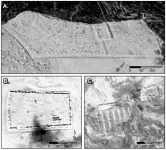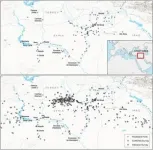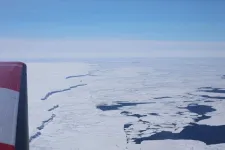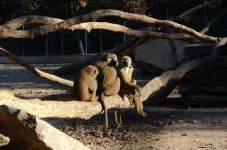(Press-News.org) Two-thousand years ago, forts were constructed by the Roman Empire across the northern Fertile Crescent, spanning from what is now western Syria to northwestern Iraq.
In the 1920s, 116 forts were documented in the region by Father Antoine Poidebard, who conducted one of the world's first aerial surveys using a WWI-era biplane. Poidebard reported that the forts were constructed from north to south to establish an eastern boundary of the Roman Empire.
A new Dartmouth study analyzing declassified Cold War satellite imagery reveals 396 previously undocumented Roman forts and reports that these forts were constructed from east to west. The analysis refutes Poidebard's claim that the forts were located along a north-south axis by showing that the forts spanned from Mosul on the Tigris River to Aleppo in western Syria.
The results are published in Antiquity.
"I was surprised to find that there were so many forts and that they were distributed in this way because the conventional wisdom was that these forts formed the border between Rome and its enemies in the east, Persia or Arab armies," says lead author Jesse Casana, a professor in the Department of Anthropology and director of the Spatial Archaeometry Lab at Dartmouth. "While there's been a lot of historical debate about this, it had been mostly assumed that this distribution was real, that Poidebard's map showed that the forts were demarcating the border and served to prevent movement across it in some way."
For the study, the team drew on declassified Cold-War era CORONA and HEXAGON satellite imagery collected between 1960 and 1986. Most of the imagery is part of the open-access CORONA Atlas Project through which Casana and colleagues developed better methods for correcting the data and made it available online.
The researchers examined satellite imagery of approximately 300,000 square kilometers (115,831 square miles) of the northern Fertile Cresent. It is a place where sites show up particularly well and is archaeologically significant, according to Casana. The team mapped 4,500 known sites and then systematically documented every other site-like feature in each of the nearly 5 by 5 kilometer (3.1 mile by 3.1 mile) survey grids, which resulted in the addition of 10,000 undiscovered sites to the database.
When the database was originally developed, Casana had created morphological categories based on the different features evident in the imagery, which allows researchers to run queries. One of the categories was Poidebard's forts—distinctive squares measuring approximately 50 by 100 meters (.03 x .06 miles), comparable in size to about half a soccer field.
The forts would have been large enough to accommodate soldiers, horses, and/or camels. Based on the satellite imagery, some of the forts had lookout towers in the corners or sides. They would have been made of stone and mud-brick or entirely of the latter, so eventually, these non-permanent structures would have melted into the ground.
While most of the forts that Poidebard documented were probably destroyed or obscured by agriculture, land use, or other activities between the 1920s and 1960s, the team was able to find 38 of 116 of Poidebard's forts, in addition to identifying 396 others.
Of those 396 forts, 290 were located in the study region and 106 were found in western Syria, in Jazireh. In addition to identifying forts similar to the walled fortresses Poidebard found, the team identified forts with interior architecture features and ones built around a mounded citadel.
"Our observations are pretty exciting and are just a fraction of what probably existed in the past," says Casana. "But our analysis further supports that forts were likely used to support the movement of troops, supplies, and trade goods across the region."
Casana is available for comment at Jesse.J.Casana@dartmouth.edu. David Goodman '22 and Carolin Ferwerda, a research associate in the Spatial Archaeometry Lab at Dartmouth, also contributed to the study.
###
END
Cold War spy satellite imagery reveals Ancient Roman forts
An analysis of declassified imagery identifies 396 forts spanning from Syria to Iraq
2023-10-27
ELSE PRESS RELEASES FROM THIS DATE:
Call for Papers: JMIR Neurotechnology
2023-10-27
JMIR Neurotechnology, published by JMIR Publications, welcomes submissions from researchers, clinicians, caregivers, and technologists that explore novel diagnostic and treatment tools for neurological disorders, particularly those leveraging the potential of neurotechnology.
The scope of the journal includes but is not limited to:
Neuroradiology
Advancements in neurosurgery
Innovative diagnostic tools and techniques
Cutting-edge neurotechnology for therapeutics
Data sharing and open science in neurotechnology
Code ...
fMRI study finds correlated shifts in brain connectivity associated with overthinking in adolescents
2023-10-27
COLUMBUS, Ohio – A new study from The Ohio State University Wexner Medical Center and College of Medicine, University of Utah and University of Exeter (UK) substantiates previous groundbreaking research that rumination (overthinking) can be reduced through an intervention called Rumination-focused Cognitive Behavioral Therapy (RF-CBT). In addition, the use of fMRI technology allowed researchers to observe correlated shifts in the brain connectivity associated with overthinking.
Study findings are published online in the journal Biological Psychiatry Global Open Science.
“We know adolescent ...
Meltwater flowing beneath Antarctic glaciers may be accelerating their retreat
2023-10-27
A new Antarctic ice sheet modeling study from scientists at UC San Diego’s Scripps Institution of Oceanography suggests that meltwater flowing out to sea from beneath Antarctic glaciers is making them lose ice faster.
The model’s simulations suggest this effect is large enough to make a meaningful contribution to global sea-level rise under high greenhouse gas emissions scenarios.
The extra ice loss caused by this meltwater flowing out to sea from beneath Antarctic glaciers is not currently accounted for in the models generating major sea-level ...
Underwater robot finds new circulation pattern in Antarctic ice shelf
2023-10-27
ITHACA, N.Y. – More than merely cracks in the ice, crevasses play an important role in circulating seawater beneath Antarctic ice shelves, potentially influencing their stability, finds Cornell University-led research based on a first-of-its-kind exploration by an underwater robot.
The remotely operated Icefin robot’s climb up and down a crevasse in the base of the Ross Ice Shelf produced the first 3D measurements of ocean conditions near where it meets the coastline, a critical juncture known as the grounding zone.
The robotic survey revealed a new circulation pattern – a jet funneling water sideways through the crevasse – in addition to rising and sinking currents, ...
Like humans, baboons are strategic cooperators
2023-10-27
A team led by CNRS scientists1 has discovered that, just like humans, Guinea baboons develop complex strategies to select partners for cooperation, basing their decisions on past interactions. Humans naturally engage in strategic cooperation in many contexts. For example, when children help schoolmates by lending them their class notes, they may expect the same in return the next time: this is known as reciprocity. But if the favour is not returned, they are likely to seek others with whom to cooperate.
The team’s findings ...
Hidden way for us to feel touch uncovered by Imperial researchers
2023-10-27
Imperial researchers have discovered a hidden mechanism within hair follicles that allow us to feel touch.
Previously, touch was thought to be detected only by nerve endings present within the skin and surrounding hair follicles. This new research from Imperial College London has found that that cells within hair follicles – the structures that surround the hair fibre – are also able to detect the sensation in cell cultures.
The researchers also found that these hair follicle cells release the neurotransmitters histamine and serotonin in response to touch – findings that ...
Study: Metformin can help youth manage weight gain side effect of bipolar medications
2023-10-27
A new large-scale study led by researchers at the University of Cincinnati and Northwell Health, New York's largest health care provider, found the drug metformin can help prevent or reduce weight gain in youth taking medication to treat bipolar disorder.
The collaborative team presented its findings during a symposium at the American Academy of Child and Adolescent Psychiatry conference in New York City Oct. 27.
Weight gain side effect
Medications to treat bipolar disorder, known as second-generation antipsychotics (SGAs), are often effective at helping young ...
AI can alert urban planners and policymakers to cities’ decay
2023-10-27
By April Toler
More than two-thirds of the world’s population is expected to live in cities by 2050, according to the United Nations. As urbanization advances around the globe, researchers at the University of Notre Dame and Stanford University said the quality of the urban physical environment will become increasingly critical to human well-being and to sustainable development initiatives.
However, measuring and tracking the quality of an urban environment, its evolution and its spatial disparities is difficult due to the amount of on-the-ground data needed to capture these patterns. To address the issue, Yong Suk Lee, assistant professor of technology, ...
NASA rocket to see sizzling edge of star-forming supernova
2023-10-27
A new sounding rocket mission is headed to space to understand how explosive stellar deaths lay the groundwork for new star systems. The Integral Field Ultraviolet Spectroscopic Experiment, or INFUSE, sounding rocket mission, will launch from the White Sands Missile Range in New Mexico on Oct. 29, 2023, at 9:35 p.m. MDT.
For a few months each year, the constellation Cygnus (Latin for “swan”) swoops through the northern hemisphere’s night sky. Just above its wing is a favorite target ...
IU scientists part of NIH-funded national consortium focused on improving Alzheimer’s disease diagnoses
2023-10-27
INDIANAPOLIS—Researchers at Indiana University School of Medicine will play key roles in a national consortium led by Wake Forest University School of Medicine to study the use, interpretation and implementation of biomarkers to diagnose Alzheimer’s disease.
The multi-institution effort is funded by a five-year, $9 million grant from the National Institute on Aging, part of the National Institutes of Health, that will establish the Alzheimer’s Diagnosis in Older Adults with Chronic Conditions (ADACC) Network.
IU School of Medicine’s Nicole Fowler, ...
LAST 30 PRESS RELEASES:
Making lighter work of calculating fluid and heat flow
Normalizing blood sugar can halve heart attack risk
Lowering blood sugar cuts heart attack risk in people with prediabetes
Study links genetic variants to risk of blinding eye disease in premature infants
Non-opioid ‘pain sponge’ therapy halts cartilage degeneration and relieves chronic pain
AI can pick up cultural values by mimicking how kids learn
China’s ecological redlines offer fast track to 30 x 30 global conservation goal
Invisible indoor threats: emerging household contaminants and their growing risks to human health
Adding antibody treatment to chemo boosts outcomes for children with rare cancer
Germline pathogenic variants among women without a history of breast cancer
Tanning beds triple melanoma risk, potentially causing broad DNA damage
Unique bond identified as key to viral infection speed
Indoor tanning makes youthful skin much older on a genetic level
Mouse model sheds new light on the causes and potential solutions to human GI problems linked to muscular dystrophy
The Journal of Nuclear Medicine ahead-of-print tip sheet: December 12, 2025
Smarter tools for peering into the microscopic world
Applications open for funding to conduct research in the Kinsey Institute archives
Global measure underestimates the severity of food insecurity
Child survivors of critical illness are missing out on timely follow up care
Risk-based vs annual breast cancer screening / the WISDOM randomized clinical trial
University of Toronto launches Electric Vehicle Innovation Ontario to accelerate advanced EV technologies and build Canada’s innovation advantage
Early relapse predicts poor outcomes in aggressive blood cancer
American College of Lifestyle Medicine applauds two CMS models aligned with lifestyle medicine practice and reimbursement
Clinical trial finds cannabis use not a barrier to quitting nicotine vaping
Supplemental nutrition assistance program policies and food insecurity
Switching immune cells to “night mode” could limit damage after a heart attack, study suggests
URI-based Global RIghts Project report spotlights continued troubling trends in worldwide inhumane treatment
Neutrophils are less aggressive at night, explaining why nighttime heart attacks cause less damage than daytime events
Menopausal hormone therapy may not pose breast cancer risk for women with BRCA mutations
Mobile health tool may improve quality of life for adolescent and young adult breast cancer survivors
[Press-News.org] Cold War spy satellite imagery reveals Ancient Roman fortsAn analysis of declassified imagery identifies 396 forts spanning from Syria to Iraq






